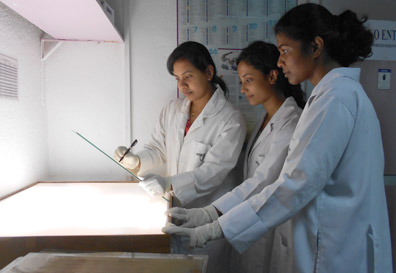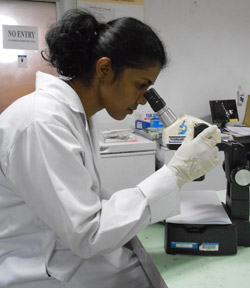DNA to the rescue
How Genetech found the real perpetrator of Seya's
rape and murder:
by Carol Aloysius
A wave of crimes against mainly children reached its peak with the
rape and killing of five-year-old Seya Sadewmi, whose body was dumped in
a canal close to her home at Kotakadeniyawa.
|

Gene Tech Institute a leading pioneer in using DNA evidence
to solve crimes and prevent crimes in Sri Lanka using
sophisticated tools to identify perpetrators in its lab at
Narahenpita |
Seya would have celebrated her fifth birthday on - September 11-the
day she was buried, her parents having even chosen the cake and frock
she was to wear for the occasion. Her murder, although one in an
increasing list of child rape and murders that have taken place this
year, shocked and stunned the Lankan public.
As the manner in which the murder was supposedly committed ( based
mostly on conjecture initially,) unfolded on television screens and in
newspapers, there was a collective demand for justice and a quick
sentencing of the perpetrator. In the weeks that followed, as
conflicting theories on who was responsible for the heinous killing of a
pre-schooler swirled, neighbours, friends and acquaintances of the
deceased child's family added fuel to fire with their contradictory
first hand knowledge, on how the crime had taken place and who was
responsible for it.
Fingers pointed at first to a 17- year- old school boy and then at a
father of one. In the case of the schoolboy, the Police found a photo of
the little girl on his mobile phone. He was allegedly assaulted at the
police station while being interrogated, the boy was found to be
innocent of the murder. Then it was 32-year-old Dinesh Priyashantha
alias 'Kondaya'. After admitting to having committed the crime giving
the Police a gruesome description of how he had allegedly committed his
horrific act and spent time in jail, Kondaya suddenly decided to
retract.The real murder he charged was not he but his older brother
Saman Jayalath.
New twist
In a new twist to this Who Dunnit mystery, it was reported just a few
days ago that a petition was filed with the Sri Lanka Human Rights
Commission (SLHRH) by the President of the Teachers Union Joseph Stalin
, stating that the two reports compiled by the Judicial Medical Officer
(JMO) during the investigations, contained contradictions and
inconsistencies. He charged that the evidence had been 'doctored'in
order to complete the case as soon as possible.
On Tuesday this week, the final report with regard to the murder was
submitted to the Negombo Magistrate by Genetech Institute a leading
pioneer in using DNA evidence to solve crimes and prevent crimes in Sri
Lanka using a number of sophisticated tools to identify the perpetrators
in its lab at Narahenpita, which incidentally received the ISO 15189
2007.
DNA testing
Senior Scientist and Head of the Molecular Forensics Dept. at
Genetech, Dr. Ruwan Illeperuma, explained the procedure used and why DNA
testing is hundred percent accurate when applied to identify
perpetrators of crimes such as Seya's rape and murder.
 Asked if he believed that DNA, an acronym for Deoxribonucleic Acid,
an evidence in criminal investigation has grown in recent years and was
now recognised as one of the most powerful tools in solving crimes in
Sri Lanka, he answered in the affirmative. Why? " Because it contains
all the genetic information about a person. It is in fact the
instructions for the body's entire genetic make-up phonotypical and
functional traits." How can it help to identify a particular person as
the criminal? "Because it is unique to each individual person. Each
person has the same DNA throughout his entire body and it is located in
almost every cell but is different from every other individual."
Describing what these cells were, he said, "Cells are the basic building
blocks of all people." Asked if he believed that DNA, an acronym for Deoxribonucleic Acid,
an evidence in criminal investigation has grown in recent years and was
now recognised as one of the most powerful tools in solving crimes in
Sri Lanka, he answered in the affirmative. Why? " Because it contains
all the genetic information about a person. It is in fact the
instructions for the body's entire genetic make-up phonotypical and
functional traits." How can it help to identify a particular person as
the criminal? "Because it is unique to each individual person. Each
person has the same DNA throughout his entire body and it is located in
almost every cell but is different from every other individual."
Describing what these cells were, he said, "Cells are the basic building
blocks of all people."
Asked for his comments with regard to DNA testing, he said, "The
first application of this technique for crime investigation in Sri Lanka
was in 1999 by the renowned DNA scientist Dr. Maya Gunasekara who was
also the founder of Genetech". " Since a person's DNA is located in
every cell throughout his entire genetic make-up the body of an
individual, any biological materials left detached from the body at the
crime scene will contain DNA .
What we usually look at, I am referring to as biological material
here are hair, blood drops, saliva, teeth, mucus, finger nails and
semen. Other than that, we can also use physical objects as DNA evidence
such as cigarettes butts, clothes, stamps, leftover food with bite marks
and used cups and used chewing gum."
Precautions
Citing examples of precautions law enforcement officers take to
prevent contamination of DNA evidence at a crime scene, he said they had
to wear gloves and face masks, avoid coughing or sneezing on the DNA
evidence, preventing samples being exposed to storage of DNA evidence in
direct sunlight, excessive moisture or increased temperature and use
paper bags or envelopes instead of plastic bags which retain moisture
that may damage the evidence during long -term storage. Even if a sample
is contaminated with erogenous DNA, that can readily be identified
during a proper testing procedure". He further added "All Scene of Crime
officers Officers (SOCO) in the Department of Police have been specially
trained in identifying, handling and preserving biological samples to be
used for DNA testing", he added.
Commenting on DNA testing used at the recent crime scene in the Seya
murder case, he said they came up with the final conclusion only after
the tests carried out on the two brothers, Kondaya and Saman Jayalath
have conclusively proved that the DNA profile and DNA samples recovered
from Saman Jayalath's blood sample and the DNA profile recovered from
the deceased individual were found to be 100 percent identical. Our
final report submitted to Court was a very comprehensive DNA report with
ten pages having multiple additional conclusions we made other than
identifying the real perpetrator.
Process
On the process followed, he said they first had to get the biological
samples recovered from the scene of the crime and autopsy as DNA
evidence and get them tested for the DNA. "Each biological sample
submitted to us has been individually tested to obtain their unique DNA
profile. Thereafter, we analyse all the data available to us at that
time, comparing the profiles and identifying the DNA sources i.e. number
of individuals who have left samples at the crime scene. We then report
to the Court that we have obtained DNA profiles and ask the Court to
submit to us possible suspects for the Comparison Process to establish
the origin of each biological sample and to conclude the analysis.
Once the suspects are produced, the DNA is extracted from a few drops
of blood obtained upon written consent from each suspect to obtain each
DNA profile. These profiles will then be compared with the DNA profiles
of each biological sample recovered from the scene and the autopsy
already obtained. If we get a perfect match upon comparison, it
concludes beyond doubt, the relevant suspect is the source of that
particular biological sample."
By doing such comparisons he said the intention was to establish the
source or identify the perpetrator. "However, if DNA profiling data is
analysed in depth, an experienced Forensic geneticist can also reveal
other additional facts such as close family relationships of a
particular individual which might include maternal and paternal history
of the individual and also other close family relationships like
maternity, paternity and siblingships. This additional information which
cannot be usually revealed through conventional evidence collected
during an investigation are extremely valuable in understanding the
chain of events that have happened during a crime incident", he added.
Nor is this the end of a Who Dunnit crime that has roused all Lankans
from their comfort zones.
According to informed sources, the exact testing procedure and
decision made during the entire procedure of DNA testing for this
particular case by Genetech , are likely to be revealed when the case is
submitted to the High Court. |

